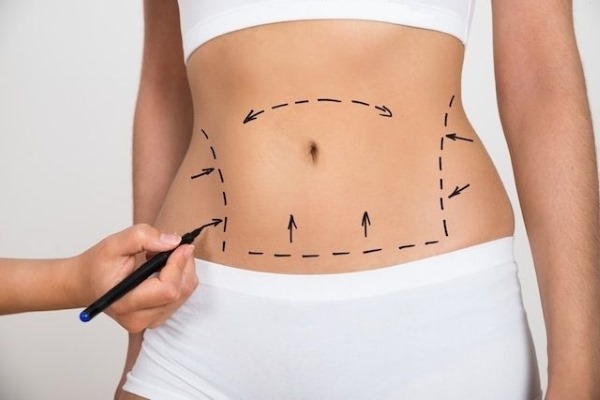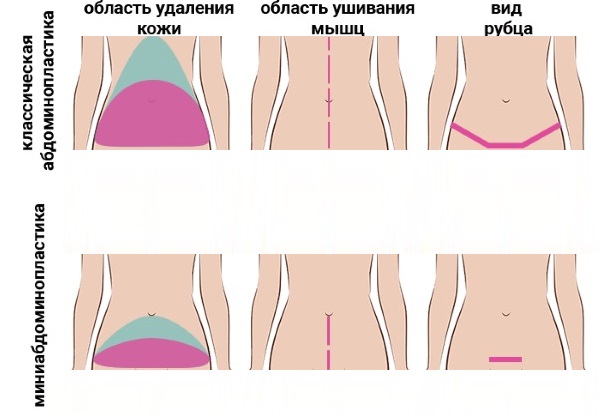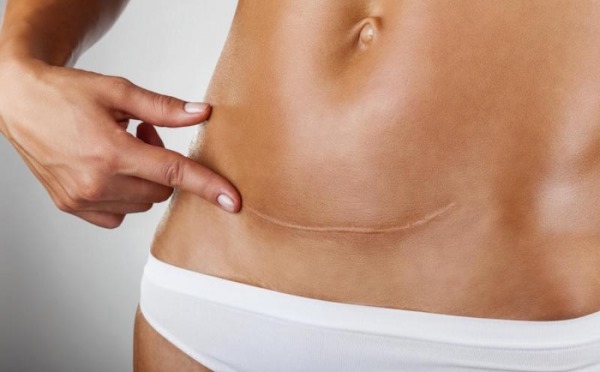Plastic correction of the abdomen is resorted to as a last resort when nothing else helps, or when there is no opportunity to go in for sports.
Today, abdominoplasty of the abdomen is almost the most popular procedure in aesthetic surgery, along with Botox injections and liposuction, since it is these procedures that give the most effective result of appearance correction. Photos before and after the methods provide an excellent opportunity to verify this.
Types of abdominoplasty
The specific type of abdominal plastic surgery is chosen by the doctor depending on the nature and volume of fatty deposits, the patient's age, individual characteristics of the body and some other factors that affect the complexity of the operation.
Surgical intervention lasts an average of 2 to 5 hours. The patient at this time is under general anesthesia, gas endotracheal anesthesia is applied.
With adipose tissue aspiration
This is a classic method of surgery, including correction of deformities of the anterior abdominal wall and liposuction - removal of fat depots. The technique allows you to form a thin waist, excess skin is removed from all parts of the abdomen and most of the adipose tissue.
Abdominoplasty with aspiration is performed in patients with high abdominal ptosis (3-4 degrees of deformity), with an apron-type skin fold. If necessary, the surgeon touches the areas on the sides of the torso. The classic intervention is prescribed to get rid of diastasis (divergence of the rectus abdominis muscles) and hernial formations.
The operation is carried out in several stages:
- The contours of the skin areas to be removed are marked.
- On the planned line, the surgeon makes an incision in the lower abdomen (in the skin fold along the line of the pelvic bones and above the pubic part).
- By sequential detachment, the skin is dissected to the edges of the ribs and lateral lines of the torso.
- The skin is cut in the navel area, then the umbilical area is exfoliated.
- Excessive skin tissue and fat mass are removed.
- Removal of hernia or diastasis is performed (cases of rectus muscles are stitched along the white line of the abdomen).
- The aponeurotic system of the abdomen is strengthened by pulling the upper section of the skin towards the pubic part.
- The planned areas of excess skin are excised and stretched.
- The incision is sutured with a cosmetic suture.
- Drainage tubes are placed under the skin to avoid fluid buildup in the wound area.
Mini abdominoplasty
The common type of surgery takes about 2.5 hours. Experts recommend it to patients without an excessive amount of fatty accumulations, if there are imperfections in the waist and abdomen, for example, severe diastasis after pregnancy, stretch marks, stretched loose skin.In this way, the abdomen is pulled up along the lower sector, the transfer of the navel is not required.
The features of mini-abdominoplasty include the technique of execution:
- Priumblicny method with two circular incisions in the umbilical region (goal: to get rid of sagging skin and small folds around the navel). The wound is sutured with a purse-string suture. After a while, the seam is almost invisible.
- Technique for performing an incision along the "bikini line" (to get rid of stretch marks in the area below the navel). Excess tissue is pulled up to the level of the umbilical region, and muscle tissue is sutured and strengthened. A cosmetic suture is applied.
- Atraumatic skin de-epidermis techniquethat is, only the surface layer of the skin is removed. The method is intended for the restoration of the abdomen with minor defects.
Medium abdominoplasty
The main goal is excision of sagging abdominal tissues ("getting rid of the apron" - this is the translation of the name of this type of operation (apronectomy). In essence, this operation is a cross between classical adominoplasty and mini-abdominoplasty. This operation is prescribed to patients with a clear excess of skin in the lower abdomen, which will not be enough to conduct a mini - operation.
The process of a secondary abdominoplasty includes:
- general anesthesia lasting 2.5 hours;
- short scar on the skin;
- elimination of a small amount of adipose tissue.
Complete abdominoplasty with or without umbilical ring repair
An operation of this type (abdominal torsoraphy) affects, in addition to the abdominal tissues, the lateral surfaces, the back with the buttocks. The result before and after can be compared in the photographs. Surgical intervention ensures that the navel is transferred to the correct position (in the middle of the abdomen relative to the pubis and the sternal xiphoid process).
It is done for patients with a large mass of fatty deposits, stretched skin and stretch marks on the back and sides, pronounced umbilical hernia.
The following defects of the umbilical ring are distinguished:
- the navel is strongly protruding and protruding;
- the umbilical fossa is too deep, due to the accumulation of secretions of the sebaceous glands, it is prone to inflammation;
- the navel is too wide, longitudinally or laterally stretched;
- sagging navel;
- lateral displacement or very low / high position;
- scars from previous operations.
Details of the surgery with the umbilical ring plasty:
- Excess skin is excised.
- The navel is transposed either to its usual place, or to a new one with the formation of a new hole in the skin.
Vertical abdominoplasty
Recommended by surgeons for patients with a vertical scar running along the midline or pubic area - from past operations. Often there are oblique scars on the right in the ileal part of the abdomen (after removal of appendicitis) or on the right under the ribs (after cholecystectomy).
The vertical method is used if a significant excess of tissue is observed on the sides of the patient and above the umbilical region (suitable for obese people). The method works well with a strong divergence of the abdominal muscles (stage 3 diastasis). Method of execution: a vertical incision is made, in addition, a horizontal approach is performed, typical of classical abdominoplasty.
Advantages of the method:
- a large layer of tissue is cut off along the middle zone of the abdomen;
- the surgeon can separate the edges of the skin with adipose tissue in the approach of the sutured parts of the aponeurosis of the anterior abdominal wall;
- a noticeable decrease in the patient's waist and body; a wide duplication of the aponeurosis is created along the anterior abdominal wall (while excess skin is removed in the epigastric region).

 Don't miss the most popular column article: How and why ribs are removed - efficiency, photos before and after surgery.
Don't miss the most popular column article: How and why ribs are removed - efficiency, photos before and after surgery.Lateral abdominoplasty
This involves making incisions along the side of the abdomen. Combines the technique of classical and vertical techniques, also called "tension-lateral" abdominoplasty, becausethe skin is pulled at 90 degrees to the patient's vertical axis.
The displaced tissues end up in the lateral parts of the abdomen. The method shows good results in order to shape the waist.
A slight detachment of the skin flap during the operation gives the least complications at the healing stage. A small strand of tissue on both sides of the scar will allow a thin, imperceptible trace from the intervention to form.
Abdominoplasty with waist contour
It is performed for patients who want to return the lateral areas of the abdomen to bend or form the waist line, if at the time of surgery there is a large volume of the abdomen and bulging of the anterior abdominal wall. To achieve good performance and satisfy the patient's desire, the surgeon removes one or two pairs of ribs of the lower section.
With this type of operation, excess skin is excised in the lower abdomen, while the formed suture is located below the umbilical region and, after healing, is safely hidden under the linen, without giving out surgical intervention.
Endoscopic abdominoplasty
This is a method by which a tummy tuck is performed in a gentle, atraumatic manner, sometimes accompanied by liposuction. The operation is indicated for defects of the anterior abdominal wall and unexpressed obesity, i.e. mainly for young patients with elastic skin (most often, endoscopic intervention is performed on women after childbirth to regain their slimness).
The low invasiveness of the method is caused by small punctures, and not by an incision, as with other types of abdominoplasty. Through the punctures, the muscles are sutured with endoscopic equipment, and the skin remains intact. Puncture marks become invisible after a short period of time.
Indications and contraindications for surgery
Abdominoplasty of the abdomen shows in the photo before and after that people go to the operation not only for the sake of giving an aesthetic appearance to the body, but also for weighty indications.
Indications:
- The presence of excess adipose tissue along the anterior abdominal wall and in the lateral parts of the abdomen. Redundancy refers to the mass of adipose tissue that cannot be effectively removed by liposuction, sports and diet.
- If a large area of the abdominal skin is covered with stretch marks (scar atrophy).
- If the patient does not have a pronounced waist as a feature of the constitution of the figure or as a side effect of enhanced pumping of oblique muscles. The presence of rough scars, hernias.
- With a divergence of the aponeurotic region of the anterior abdominal wall as a result of stretching factors (fullness, pregnancy or genetic weakness of the connective tissue structure). The muscles diverge along the white line of the abdomen (the so-called diastasis is formed), in some cases, in addition to diastasis, hernias of the abdomen and navel are noted.
In addition, the operation is indicated if it is necessary to carry out plastic surgery of the umbilical region and restore the navel.
This part of the abdomen is often subject to unpleasant defects due to the following reasons:
- defects during pregnancy due to hyperextension of the abdomen;
- as a result of poor-quality piercing (an unsuccessful puncture leads to inflammation, connective tissue grows in the piercing area);
- changes in the shape and location of the navel after other operations;
- with different structural features of the umbilical part of the abdomen;
- with age-related ptosis of the abdomen.
There are a number of contraindications for abdominoplasty, about which the doctor must be informed in order to make a decision on further actions.
Surgical intervention cannot be performed in the following cases:
- with acute infectious diseases or during the exacerbation of chronic diseases;
- in the presence of diabetes mellitus of any type;
- with blood diseases and problems with blood clotting factors;
- at any stage of pregnancy, during lactation and planning pregnancy in less than 1 year after abdominoplasty;
- with a tendency to form a keloid or hypertrophic scar at the site of the incision;
- with oncological diseases;
- with severe diseases of internal organs;
- with chronic heart or pulmonary failure;
- with the possibility of a crisis of arterial hypertension;
- with disorders of the thyroid gland;
- in conditions of fresh postoperative scars;
- in case of allergic reactions and intolerance to the components of local anesthesia;
- with an unstable state of the patient's psycho-emotional sphere or mental disorders;
- under the age of 18;
- with significant obesity of the patient.
In the latter case, he is advised to lose weight as much as possible through diet, physical activity before the operation. In some situations, liposuction is done prior to abdominoplasty. As they heal, they move on to preparing for abdominoplasty.
Overweight threatens to increase the postoperative period, problems with sutures.
Also, a recommendation for weight loss before surgery is received by patients whose plans included weight loss after surgery (this can damage the results of abdominoplasty, because the skin will sag, looseness and flabbiness will appear).

 Don't miss the most popular column article: Alentova Vera after plastic surgery - the last photos, what operations were performed, how the star changed.
Don't miss the most popular column article: Alentova Vera after plastic surgery - the last photos, what operations were performed, how the star changed.Memories: scars and scars
The traces from the performed abdominoplasty of the abdomen, shown in the photo before and after, thanks to the professional work of surgeons, after a while become unnoticeable. The use of high-quality suture material and a special technique of suturing surgical incisions helps to obtain a thin strip at the site of the scar.
The condition of the seam is carefully monitored for the first weeks after the operation. Cutaneous sutures must be removed after 2 weeks, intradermal sutures made with self-absorbing suture threads, or adhesive sutures are not touched, only processed.
If the abdominoplasty of the abdomen was very serious, the photos before and after show the difference, and the scars are visible, you can resort to modern cosmetology. To eliminate scars and scars, laser resurfacing and radiolifting procedures or retouching with medical tattooing for an aesthetic look are used.
The rehabilitation period and possible complications
Abdominoplasty entails a long recovery period. The first 1 - 1.5 months are especially difficult; in general, rehabilitation takes 6 months.
After the operation, the patient must be under medical supervision for at least 3 days, of which:
- The first day the patient is in the ward. Nothing is immediately allowed from food, and after the restoration of intestinal functions, light food can be taken. Water intake is allowed.
- On the second day, the patient begins to gently get out of bed, light food and drink are allowed.
- On the third day after examination by the surgeon and depending on the condition of the operated person, the issue of discharge is decided.
General health after abdominoplasty is marked by painful sensations and tension in the middle region of the trunk. The discomfort can last up to 3 weeks - some patients even need help getting up from a horizontal position.
The observing doctor will recommend the patient to stay in bed, limit loads, and give a number of recommendations:
- The need to wear compression garments for at least 1 - 2 months after surgery. Fixing with linen helps healing and prevents the seams from coming apart.
- Proper nutritious nutrition. The postoperative period is not the time for diets.
- Daily regimen without overload (ban on fitness, baths, saunas).
- A minimum of water procedures so that the seam does not come into contact with water. A regular shower is allowed one week after the operation, but the seam must be protected from soap and detergents.
- Treatment of the seam with antiseptic solutions three times a day.
The postoperative period does not always go smoothly.If any complications occur, the patient must see his doctor without fail.
Individual reactions of the body are possible in the form of such local complications:
- Edema as the body's response to injury. Edema tends to increase throughout the first postoperative week, but this is a physiological process. Sometimes edema persists throughout the recovery period.
- If the nerve branches are affected during the operation, there may be a loss of sensitivity in the skin at the site of intervention. After a full recovery of the body, sensitivity usually returns.
- The appearance of hematomas. The accumulated blood in the upper layers of the skin is gradually absorbed. Sometimes hematomas under the skin appear after discharge. Skin hyperpigmentation may appear.
- The seam area festers if sterility is not observed or the seam is improperly processed.
- In the wound, exudate can accumulate, a seroma occurs due to a loose fit of the suture edges. Proper drainage of the separated fluids and adherence to the regime of wearing compression underwear is necessary so as not to complicate the situation.
- If a flap of tissue larger than necessary is removed during the operation, tension in the sutures occurs. This leads to marginal necrosis - tissue necrosis.
- Rough scars at the site of incision healing.
- It is dangerous if blood or fluid from the tissues accumulates in the abdominal cavities after surgery.
- The wound in the operated abdomen becomes inflamed. To avoid this, patients receive antibiotic therapy after the intervention.
- There are cases of divergence of sutures along the edge of the wound, if the patient lifted weights or overdid it in the gym.
- Grease can form over the seam.
- Chronic pain in the operated areas.
If the muscles were sewn unevenly, asymmetry of the anterior abdominal wall occurs. To remove it, the patient will have to undergo another plastic surgery or use alternative methods (filling with their own fat or filling with fillers based on hyaluronic acid).

 Don't miss the most popular column article: Cannula - what is it, how is it used in cosmetology and medicine.
Don't miss the most popular column article: Cannula - what is it, how is it used in cosmetology and medicine.When to have sex after surgery
Return to intimate life is allowed no earlier than a few weeks after the operation. Restrictions are introduced due to edema, discomfort, risk of seam divergence. During sex, there is a rush of blood in the pelvic area, which is undesirable during the recovery period.
The exact timing of the return of sexual life depends on the well-being of the operated person, on average, they are resolved 1 month after the surgery.
Is it possible to give birth after abdominoplasty
Experts recommend that women give birth first, and then engage in bringing the abdomen into an aesthetic form. During pregnancy, the abdominal tissue is exposed to excessive tension, which can affect the results of the operation.
But if the patient decided to become pregnant after a tummy tuck - and this operation only affected the skin and adipose tissue without damaging the muscle fibers - then the anterior abdominal wall can withstand the load for 9 months. The mode of delivery is in no way associated with the presence of abdominoplasty and lies entirely in the field of obstetrics.
Pay for beauty: how much it costs and how long the result lasts
The level of costs for surgery, hospital stay, anesthesia, tests and related services can be determined based on the type of surgery. First you need to consult a surgeon. On average, the price starts at 140 thousand rubles. You can find out the approximate prices on the websites of clinics practicing abdominoplasty of the abdomen, there you can also see the photos before and after.
It is difficult to decide on an operation, because of anesthesia, postoperative recovery, and a considerable cost of the procedure. However, the result of abdominoplasty will last for years to come, this is a reasonable contribution to maintaining harmony.
Video about abdominoplasty of the abdomen. Photos before and after surgery
When an abdominoplasty of the abdomen is required:






My sister did a mini tummy tuck. I am very satisfied: the stomach does not stick out, the shovel is thin, invisible under the bikini.
Many thanks to G.I. Tumakov. to the Frau Clinic specialist for my beautiful belly! I just can't get enough of it. If someone else doubts whether it is necessary or unnecessary to get rid of these folds that cannot be removed by anything, then I advise you to cast aside doubts and trust the specialists. I made up my mind for a long time, but now I don't regret it. Thank you very much for your newly acquired slimness! Prosperity and success for the clinic! You give people not only beauty, but also faith in themselves.
My abdominoplasty went well only the second time. The first one was not very efficient. Removed ptosis and sagging abdominal skin. Now I feel like a different person, really. But it is important to undergo a recovery course correctly.
I did it at Ivanchenkova Tatiana Alexandrovna
very happy with the result
I first did liposuction, three years ago, but I will say that I am very happy, so I decided to do an abdominoplasty, now I am very happy with the result, a flat beautiful tummy, but there is a scar, but it is hidden under the underwear, and nothing is visible in the swimsuit , thanks to my Dr. Gower, we have excellent results, I am proud of my figure!